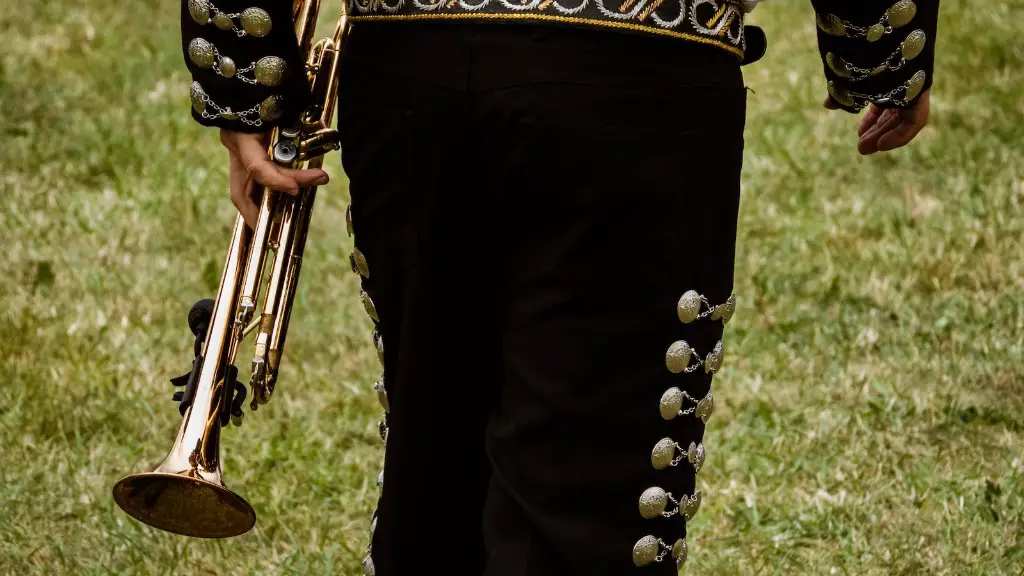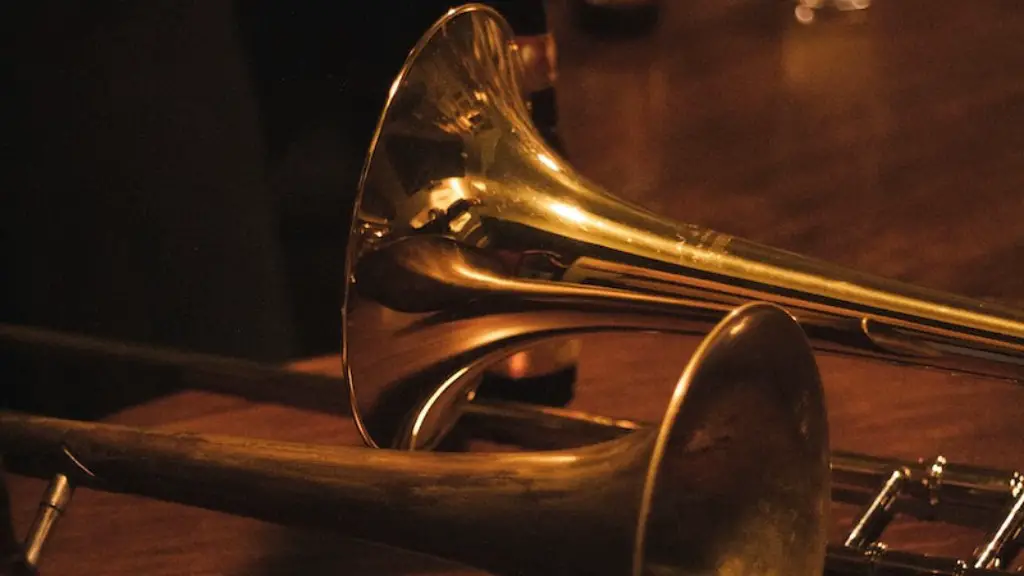Playing low notes on a trumpet can be tricky, especially for beginners. It requires a special technique and the right breathing exercises to make the most of it.
In order to play low notes on a trumpet, you need to focus on producing a deep, resonant sound with your lips. You should start by warming up your lips by playing long tones in the lower register of the trumpet. This will help you build strength and endurance in your embouchure muscles. Additionally, you should practice breathing deeply from your diaphragm and using good posture to ensure that your air column is stable and consistent.
You also need to pay close attention to your mouthpiece placement when playing low notes on a trumpet. It should be placed slightly off center so that the air stream is directed more towards the back of the mouthpiece. This will help create a fuller, deeper sound that will resonate with the lower notes.
Lastly, it is important to practice regularly and don’t get discouraged if you have difficulty reaching those low notes at first. With some patience and dedication, you will soon be able to confidently play any note on your trumpet!
Playing Low Notes on Trumpet
Playing low notes on the trumpet requires a few basic steps. Begin by ensuring you have a properly-sized mouthpiece for your instrument. This will allow the air to flow freely and make it easier to play lower notes. Next, practice buzzing your lips together, as this will help you achieve the correct embouchure for playing low notes. Make sure you are not pressing down too hard and that your lips are relaxed. Once you have developed your embouchure, practice long tones in the low register. Use a metronome or tuner to ensure that you are playing in tune and with good tone quality.
It is important to practice playing low notes regularly until they become part of your muscle memory. You can also try using different fingerings to find the one that works best for you. Concentrate on keeping a steady airflow while playing and focus on developing a full sound. With some practice, you will be able to play low notes confidently and accurately on the trumpet!
Low Range Exercises for Trumpet
Playing low notes on trumpet can be difficult for some players. However, with practice and the right exercises, anyone can master the lower notes. One of the first tips is to focus on playing with a relaxed embouchure. This will help create a more open sound and allow for easier access to the lower range. Additionally, it’s important to practice long tones and slurs as this will help with endurance and intonation.
In addition to long tones, practice lip flexibility drills such as lip trills. This will help increase your range while also helping you develop faster articulations. Another helpful exercise is overtones which can help you learn how to adjust your embouchure when playing different notes. Finally, don’t forget to listen while practicing low range exercises as this will help you better understand how the sound should feel and sound when playing low notes.
Playing Low Notes on Trumpet
The trumpet is a versatile instrument, capable of producing a wide range of notes. To play the lowest notes on the trumpet, it is important to use the correct mouthpiece and embouchure. The bell of the trumpet should be angled slightly downwards to ensure that the notes project outwards. The mouthpiece should be placed on the lower lip and held firmly in place with the lips, teeth, and chin. It is also important to keep the corners of your mouth relaxed when playing low notes as this will allow air to flow freely. To get a good sound, it is essential to use proper breath support when playing low notes on the trumpet.
When playing low notes, it is important to focus on using your diaphragm muscle instead of your throat muscles. This will help create a more focused sound and reduce fatigue in your lips. Additionally, it is important to practice playing low notes with different articulations such as staccato and legato in order to develop control over pitch and tone quality. Taking slow breaths during practice sessions can also improve your ability to play low notes accurately.
Finally, it is essential for all trumpeters to practice regularly in order to maintain consistency in their playing. Practicing scales and exercises specifically designed for low notes can help build strength and accuracy when playing these difficult passages. With consistent practice, you can master the art of playing low notes on trumpet!
Posture and Breath Control for Playing Low Notes on Trumpet
Playing low notes on trumpet requires proper posture and breath control. When playing low notes, the trumpeter should stand up straight with their feet shoulder-width apart and knees slightly bent. The trumpet should be held in an upright position at a 45-degree angle from the floor. The arms should be relaxed and the elbows slightly bent to create a comfortable playing angle.
Breath control is also essential for playing low notes on trumpet. Before starting to play, take a deep breath and exhale slowly while keeping the air flowing continuously through the trumpet. This will ensure that the sound is steady and consistent throughout each note. It is important to practice this technique regularly to improve accuracy and range when playing low notes on trumpet.
In addition, it is important to keep the tongue relaxed while playing low notes as this will help create a clear sound with no buzzing or raspy noise. The embouchure should be firm but not overly tight, as this can cause tension in the jaw muscles which can affect your ability to play low notes accurately. With practice and dedication, any trumpeter can master these techniques to become proficient in playing low notes on trumpet.
How the Tongue Affects the Pitch of Low Notes
The tongue is an important factor when it comes to playing low notes on trumpet. It can affect the pitch and tone of the notes, as well as the overall sound quality. The tongue should be relaxed but firm, and should be used to articulate the notes. When playing low notes, it is important to use a relaxed tongue position so that the sound does not become too sharp or shrill. To achieve this, use a gentle pressure on the back of the tongue and keep it slightly curved towards the back of your throat.
When playing low notes, it is also important to keep your breath steady and maintain a consistent air stream. This will ensure that each note is produced with even volume and tone. Additionally, keeping your lips slightly parted can help with this by allowing more air into the mouthpiece and creating a fuller sound. Finally, make sure to practice regularly to build up your endurance and ensure you can play low notes for longer periods of time without tiring out or losing control of your pitch. With practice, you will be able to play low notes with great accuracy and clarity.
Reaching Lower Notes on Trumpet
Playing low notes on the trumpet can be difficult. To make sure you get a good, clear sound, you should use proper technique. First, focus on your breath control and aim for a steady and consistent airflow. Make sure your mouthpiece is pressed firmly against your lips and that you don’t bite down too hard. You should also keep your embouchure loose and relaxed to help create a resonant sound. When playing low notes, focus on keeping the airstream steady and pushing through with your diaphragm.
To help ensure accuracy, practice playing in first position. This will help with intonation as well as provide an opportunity to improve your articulation. Also, try using a mute to adjust the timbre of the note while maintaining the same pitch. Finally, work on ear training to develop perfect pitch so that you can better recognize when a note is out of tune. With practice and the right technique, you will be able to play low notes with confidence!
Final Words
Playing low notes on the trumpet is all about mastering your breath, posture and embouchure. The amount of air you push through the trumpet and the way you position your tongue and lips are essential for producing a full, clear tone. Use a metronome to practice maintaining consistent airflow and to ensure that your pitches are accurate. The most important thing to remember is that with practice, you can develop the skills necessary to play low notes on trumpet. With enough time and dedication, you can unlock new possibilities with your instrument.





